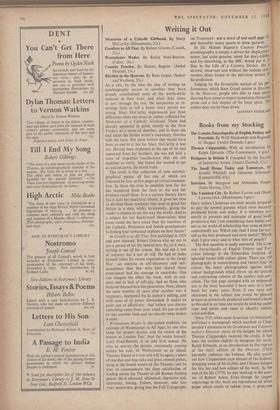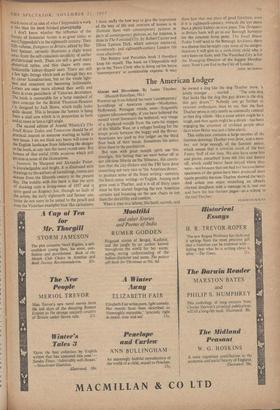Books from my Stocking
The Concise Encyclopedia of English Pottery and Porcelain. By Wolf Mankowitz and Reginald G. Haggar. (Andre Deutsch, 6 gns.) The Small House Today and Tomorrow. 13Y Arnold Whittick and Johannes Schreiner. (Leonard Hill, 45s.) Interiors. By Margaret and Alexander Potter. (John Murray, 15s.) ONLY before Christmas are most people prepared to pay- the several guineas which most decently produced books cost today. It is therefore pri- marily as presents and examples of good book production that I am considering these books and not as the works of scholarship that some of then undoubtedly are. Which one shall I keep for my- self as the best produced and most useful? Which shall I give away and to what sort of people?
The first question is easily answered. The Con- cise Encyclopedia of English Pottery and Por- celain belongs to the Edwardian tradition of splendid books with colour plates. There are 150 photographs in monochrome and twenty-four in colour, the latter photographed against dark colour backgrounds which throw up the texture and contrasting colours of the pottery and por- celain. The title page stamped with an embossed urn is the most beautiful I have seen in a new book for many years. Even if one were not interested in the subject one would be pleased to have so attractively produced and bound a book as this and in no time one would be looking under cups and plates and vases to identify maker, artist and date.
Since 1929, when some American 'art historians' published a monograph which ascribed to Chip- pendale's assistants in his Gentleman and Cabinet- maker's Director, many of the designs for which Thomas Chippendale received the credit, it has been the custom slightly to denigrate his work. Ralph Edwards, in an introduction to this reprint of the third edition of the Director (1762) learnedly redresses the balance. He also points out how Chippendale kept abreast of the fashion, dropping some of his Gothic and. Chinese designs for this last and best edition of his work. At the end of his life (1779), he was working in the man- ner of Robert Adam. Even though the copper engravings in this book are reproduced .on white paper which smells of rubber tyres, it gives one
much more of an idea of what Chippendale's work is like than the most finished photography.
I don't know whether the influence of the Society of Industrial Artists is as great today as Was Chippendale's in the eighteenth century. Their fifth volume, Designers in Britain, edited by Her- bert Spencer, certainly illustrates a slight trend away from the self-conscious simplicity of earlier prefabricated work. There are still a good many obstetrical tables, and thin chairs with once- fashionable kidney-shaped seats. There are still a few light fittings which look as though they are by clever Scandinavians, but on the whole light- ness and ornament are becoming fashionable. Letters are once more allowed their serifs and there is even pastieherie of Victorian decoration. The book is memorable for a lamp standard of spun concrete for the British Thomson-Houston Co. designed by Jack Howe, which really looks quite decent. This is because the lantern is hung from a steel arm which is in proportion to both and at more or less a right angle. The second edition of Arnold Whittick's The Small House Today and Tomorrow should be of Practical interest to someone wanting to build a new house. I do not think any harm will come to the English landscape from following the designs in the book, at any rate the more recent ones. But beware of that awful 1930s moderne which still Persists in some of the illustrations.
Interiors, by Margaret and Alexander Potter, is knowledgeable and bright. it is illustrated with drawings by the authors of furnishings, rooms and dresses from the Fifteenth century to the present day. The trouble with this book is that the style of drawing suits a living-room of 1957 and is quite good on Regency but. through no fault of the artists, the early eighteenth and former cen- turies do not seem to be suited to the pencil and even the Victorian examples look like caricatures. I think really the best way to give the impression of the way of life and interiors of houses is to illustrate them with contemporary pictures or parts of contemporary pictures, as, for instance, is done in The Vanished City, by Robert Carrier and Oliver Lawson Dick, which conveys mediaeval, seventeenth- and eighteenth-century London life most effectively.
The Pottery and Porcelain book I therefore keep for myself. The book on Chippendale will go to the Town Clerk who is doing up his house 'contemporary' at considerable expense. It may
show him that one piece of good furniture, even if it is eighteenth-century, rewards the eye more than a plastic kidney on iron pipes. The Designers in Britain book will go to our Borough Surveyor for the concrete lamp posts. The - Small House Today I will send to the Borough Architect; there is a chance that he might copy some of the designs. Interiors I will give to a sixth-form child who is very keen on facts, and The Vanished City is for the Managing Director of the biggest Develop- ment Trust 1 can find in the City of London.











































































 Previous page
Previous page